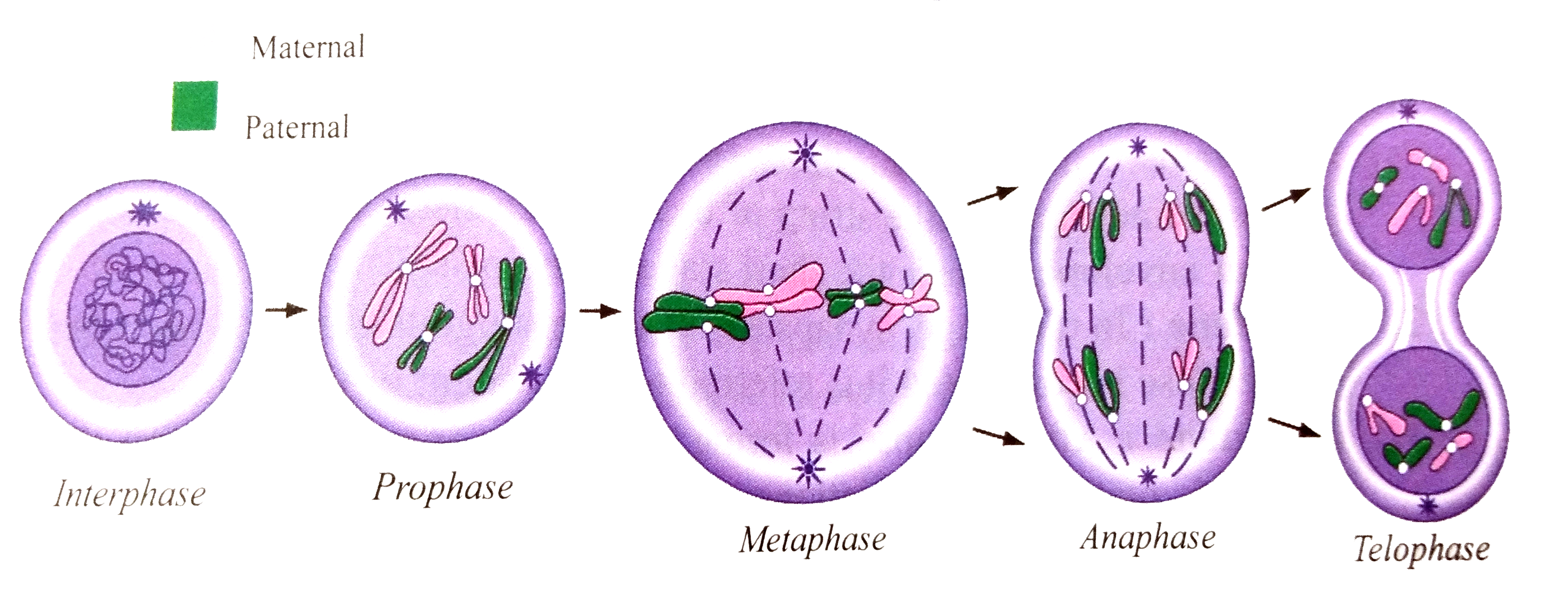With the help of labelled diagram, explain the following :
(b) Anaphase of mitosis
Step-by-Step Solution for Anaphase of Mitosis
Step 1: Introduction to Mitosis
- Mitosis is a type of cell division that results in two daughter cells, each with the same number of chromosomes as the parent cell. It is an equational division, meaning the chromosome number remains constant.
Step 2: Overview of Mitosis Stages
- Mitosis consists of several stages: prophase, metaphase, anaphase, and telophase. Anaphase is the third stage of mitosis.
Step 3: Description of Anaphase
- During anaphase, the sister chromatids, which were previously aligned at the metaphase plate, begin to separate.
- The centromeres that hold the sister chromatids together split, allowing the chromatids to move towards opposite poles of the cell.
Step 4: Role of Spindle Fibers
- The movement of chromatids is facilitated by spindle fibers.
- Kinetochore microtubules shorten, pulling the chromatids apart, while polar microtubules push the poles of the cell apart, aiding in the separation.
Step 5: Diagram of Anaphase
- Draw a diagram showing:
- Two poles of the cell
- Chromatids moving towards each pole
- Kinetochore microtubules attached to the chromatids
- Polar microtubules extending from the poles
- Label all parts clearly, including the chromatids, centromeres, and spindle fibers.
Step 6: Conclusion of Anaphase
- By the end of anaphase, the chromatids have moved to opposite ends of the cell, setting the stage for the next phase of mitosis, telophase.
- Mitosis is a type of cell division that results in two daughter cells, each with the same number of chromosomes as the parent cell. It is an equational division, meaning the chromosome number remains constant.
- Mitosis consists of several stages: prophase, metaphase, anaphase, and telophase. Anaphase is the third stage of mitosis.
- During anaphase, the sister chromatids, which were previously aligned at the metaphase plate, begin to separate.
- The centromeres that hold the sister chromatids together split, allowing the chromatids to move towards opposite poles of the cell.
- The movement of chromatids is facilitated by spindle fibers.
- Kinetochore microtubules shorten, pulling the chromatids apart, while polar microtubules push the poles of the cell apart, aiding in the separation.
- Draw a diagram showing:
- Two poles of the cell
- Chromatids moving towards each pole
- Kinetochore microtubules attached to the chromatids
- Polar microtubules extending from the poles
- Label all parts clearly, including the chromatids, centromeres, and spindle fibers.
- By the end of anaphase, the chromatids have moved to opposite ends of the cell, setting the stage for the next phase of mitosis, telophase.
Topper's Solved these Questions
- CELL CYCLE AND CELL DIVISIONBOOK - CBSE COMPLEMENTARY MATERIALCHAPTER - CELL CYCLE AND CELL DIVISIONEXERCISE - Short Answer Questions-II
5 Videos
- BREATHING AND EXCHANGE OF GASES BOOK - CBSE COMPLEMENTARY MATERIALCHAPTER - BREATHING AND EXCHANGE OF GASES EXERCISE - Long Answer Questions
3 Videos
- CELL: THE UNIT OF LIFE BOOK - CBSE COMPLEMENTARY MATERIALCHAPTER - CELL: THE UNIT OF LIFE EXERCISE - LONG ANSWER QUESTIONS
3 Videos
Similar Questions
With the help of labelled diagram, explain the following :
(a) Diplotene
View SolutionWith the help of a labelled diagram, explain the working of hydraulic brakes.
View SolutionWith the help of a labelled diagram explain the working of a transformer . Write any three source of energy loss in a transformer .
View SolutionWith the help of suitable diagrams explain the mitosis in detail.
View SolutionWith the help of suitable diagrams, explain mitosis in detail.
View SolutionWith the help of suitable diagrams, explain the mitosis in detail.

View SolutionWith the help of a labelled diagram, explain why the sun appears reddish at the sunrise and the sunset.
View SolutionWith the help of labelled diagram explain the structure of human respiratory system.
View SolutionWith the help of labelled diagram explain the exchange of gases between alveolus and capillary.
View SolutionWith the help of a neat-labelled diagram, explain the construction and working of an electric bell.
View Solution
